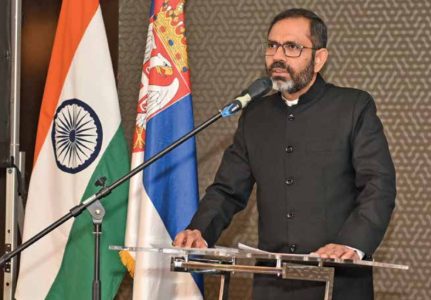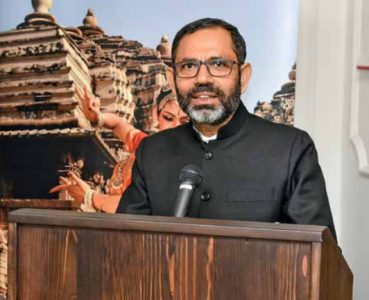India and Serbia are cooperating closely and have shared views on many major global issues

H.E. Subrata Bhattacharjee was appointed the Indian Ambassador to Serbia last year. We have talked to the Ambassador about the cooperation between Serbia and India, our diplomatic and political relations, the secret of India’s success and its culture.
Serbia still has vivid memories of the friendly relations between India and the former Yugoslavia, as well as of the Non-Aligned Movement. During this long history of diplomatic relations, the two countries have cooperated in several areas, from the economy to education. Are you satisfied with the results so far? What specific goals do you have in mind in terms of improving the bilateral relations?
– In the predominantly bipolar world prevailing after India’s independence, the Non-Aligned Movement (NAM) greatly helped many developing countries by ensuring they were not dominated by either of the world powers. The leaders of India and Yugoslavia played a pioneering role in the Non-Aligned Movement. In the 1990s, the Balkan region faced a difficult geopolitical situation. At that time, India was also preoccupied with its economic reform programme. Following that, start-ing with this millennium, the top Indian and Serbian officials began exchanging visits. Two such recent high-level visits include the visit of then Serbian PM Aleksandar Vučić, (now President) to India and India’s Vice President’s visit to Serbia in 2018. Serbian First Deputy Prime Minister & Foreign Minister Ivica Dačić also visited India in 2018. While the world has now turned multi-polar, due to the changes in geopolitics, the need for protecting a country’s interest from outside interference is still present. In this light, India and Serbia are cooperating closely and have shared views on many major global issues. One such example is India’s principled stand on respecting the sovereignty and territorial integrity of Serbia. With strong political relations, growing economic ties and close cultural affinity between our two peoples and our bilateral relations have been impressive. Trade and investments figures show a continuous increase. In terms of the education segment, I see more and more Serbian students obtaining scholarships in India under the Indian Technical and Economic Cooperation (ITEC) programme. In the coming months, we will have more exchanges of visits. There is also a possibility of holding the next Joint Economic Committee (JEC) meeting.
India has been recording a steady economic growth in recent years, which has put the country in the group of the six largest economies in the world in 2018. What made this success possible – the expansion in the IT sector, skilled labour or mass production?
– Yes, indeed, the Indian economy has made commendable progress in recent years. With the GDP amounting to US$ 2.597 trillion and 8% GDP growth, India today is the fastest-growing large economy in the world. The value of India’s annual trade stands at US$ 769 billion and has been growing at 16% per annum. How was this made possible? India’s vast pool of skilled manpower played a major role in this. India accounts for about one-sixth of humanity. Our country also has a young population. By 2020, the average age in India will be 29, making it the world’s youngest country with 64% of the population in the working-age group. India also has the third-largest scientific and technical manpower in the world who are educated at 162 universities. Sectors like Information Technology, Biotechnology and others, that rely heavily on the availability of skilled man-power, have contributed greatly to India’s growth. At the same time, India implemented an economic liberalization pr0gramme in the 1990s which has gained momentum in subsequent years. Particularly, India has implemented several economic reform measures that have improved the country’s rank on World Bank’s Doing Business Report by 53 positions in past two years. These involve the simplification of investment procedures, reduction of paperwork, the unification of tax structure etc. While all of the afore-mentioned created an investor-friend-ly climate, the flagship programmes, launched by Prime Minister Modi, such as Skill India dedicated to large-scale training of youth, Make in India aimed at boosting mass production and others, also became the catalyst in the success of India’s economy.
How can we implement Indian experiences like Digital India here?
– Digital India is a unique initiative launched by Prime Minister Modi in 2015 with the goal of connecting rural areas to high-speed Internet networks and improving digital literacy. India has a population of 1.3 billion with the 1.23 billion issued biometric IDs, 1.21 billion mobile phones (out of which 446 million are smartphones) and 560 million Internet users, which is over one-third of the country’s population. At the same time, the country has seen enormous growth in e-Commerce (over 50% annually). Keeping this in mind, the initiative is centred on three key areas – digital infrastructure as a utility for every citizen, governance and services on demand, and digital empowerment of citizens.  This initiative is meant to ensure that government services are made available to citizens electronically through the improved online infrastructure and by increasing Internet connectivity or by making the country digitally empowered in the field of technology. Greater use of online transactions also helps the government to nab tax evasion and money laundering. The Digital India initiative has also contributed to India’s cooperation with friendly, developing countries. India has been implementing a large number of programmes aimed at sharing India’s expertise in e-Governance, e-Learning, e-Literacy, etc. with other developing countries. India has signed an MoU with Serbia stipulating cooperation in IT & Electronics with the goal of boosting the cooperation in the segments of e-learning, e-government services, telemedicine, e-education, e-authentication, cybersecurity, human resources development and capacity building in IT domain. One of the practical examples of the use of e-Governance is seen in India and Serbia holding Joint Economic Committee meetings via video conferencing.
This initiative is meant to ensure that government services are made available to citizens electronically through the improved online infrastructure and by increasing Internet connectivity or by making the country digitally empowered in the field of technology. Greater use of online transactions also helps the government to nab tax evasion and money laundering. The Digital India initiative has also contributed to India’s cooperation with friendly, developing countries. India has been implementing a large number of programmes aimed at sharing India’s expertise in e-Governance, e-Learning, e-Literacy, etc. with other developing countries. India has signed an MoU with Serbia stipulating cooperation in IT & Electronics with the goal of boosting the cooperation in the segments of e-learning, e-government services, telemedicine, e-education, e-authentication, cybersecurity, human resources development and capacity building in IT domain. One of the practical examples of the use of e-Governance is seen in India and Serbia holding Joint Economic Committee meetings via video conferencing.
Are Indian businesspeople interested in investing in Serbia? The business community says there is room for cooperation which can grow significantly, especially in the food and pharmaceutical industry.
– While India itself seeks foreign investments, our country is also a major foreign investor. In the past three years, Indian companies have invested US$ 40 billion abroad. Their total financial commitment in that period amounted to US$ 120 billion. In the case of Serbia, Indian companies have already invested in sectors like manufacturing tractors, IT parks, food processing, manufacturing aluminium panels, garbage disposal containers, etc. Considering that Serbia is a member of the EU Customs Union and has FTAs with Russia and many other countries, there is great potential for attracting further investments from India. Agriculture plays a major role in the Serbian economy and needs the necessary support of the agricultural machinery sector. In the IT sector, India has the capability and Serbia can gain from this expertise. With Serbia’s growing attraction as a tourist destination, the Serbian tourism sector could be attractive too. India’s expertise in manufacturing quality medication at affordable prices can be an advantage for the Serbian pharmaceutical industry. These are just some of the potential areas for Indian companies investing in Serbia.
An increasing number of people from Serbia are visiting India and are interested in traditional disciplines like yoga, Ayurveda, and similar. Why do the Serbian citizens choose your culture and lifestyle? What kind of cultural and tourism cooperation do the two countries have, and what are the plans for this area?
– I was deeply impressed to see the spontaneous interest that the Serbian citizens have in Indian culture. The presence of numerous Yoga schools in Serbia illustrates this. With this in mind, the Indian Embassy puts a strong emphasis on promoting cultural diplomacy in Serbia. In past few years, the Indian Embassy has organized several performances with the use of Indian musical instruments such as ‘Rudra Veena’, Tabla, Guitar and ‘Stree Shakti’ Hindustani Instrumentals, and Indian classical dance performances of Kathak, Bharatnatyam, Pantomime dance (‘Where the Shadow Ends’) and Katkatha Puppet dance. During my term, I organized an exhibition of embroidery fabrics from the Himalayas (‘Rumals of Chamba’) at the National Assembly of Serbia and the exhibition in honour of 70 years of diplomatic relations between India and Serbia at the Yugoslav National Archive. In celebration of 150 years since Mahatma Gandhi’s birth, I took part in several talks, discussion forums and television shows about Gandhi. These kinds of activities will continue in the future too.
Serbia has hosted numerous cultural events from India, organized by the Indian Embassy, like concerts, dance performances and the International Yoga Day. Are you planning more such activities?
– This year’s celebration of the International Day of Yoga was a great success. The celebration took place in front of the National Assembly of Serbia with Mrs Vučić, the wife of President of Serbia, joining in. We will continue with this tradition. A Bharatnatyam performance by a dance troupe from India will take place at the Madlenianum Opera & Theatre, Zemun, on 5th August. The performance is dedicated to Gandhi and his life. The practice of Serbian dancers performing Indian dances will certainly continue, particularly at this year’s Diwali celebration. In order to promote Indian cuisine, we will participate in ‘Food Planet 2019’ in Novi Sad on 4th September. The visitors will also have the opportunity of watching Serbian girls performing Indian dances there.